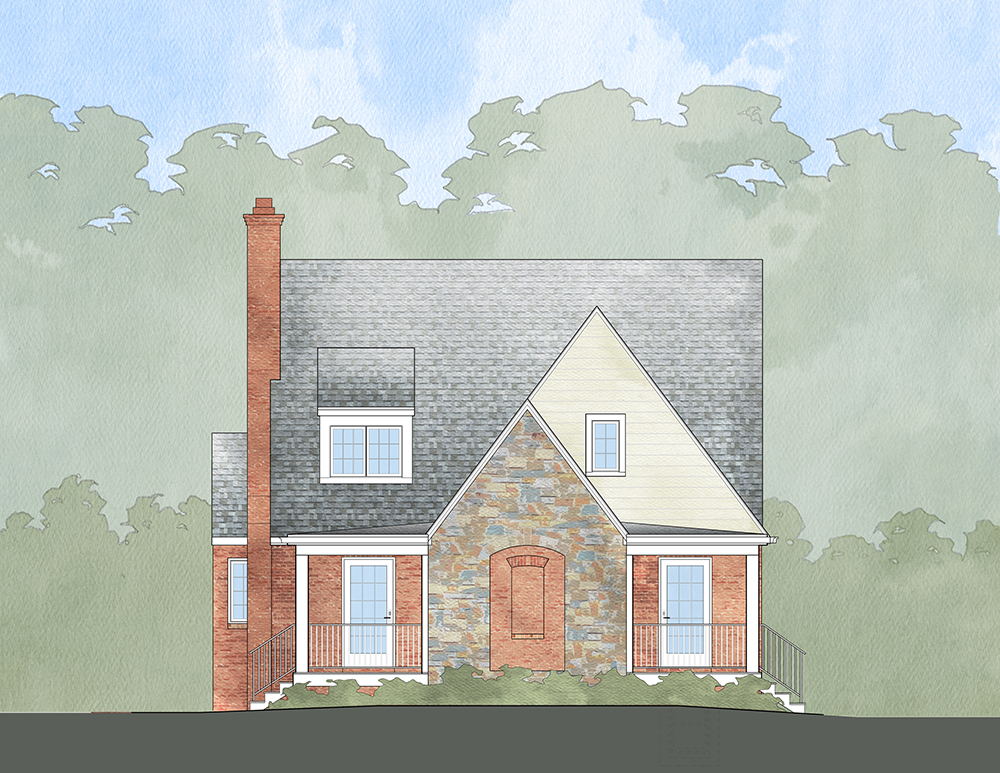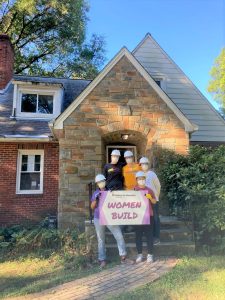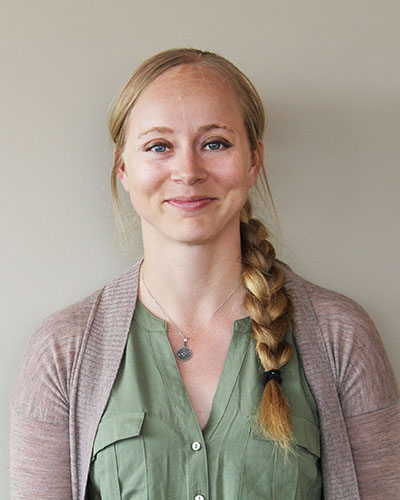By Sarah Reddinger, Vice President of Community Development, Habitat for Humanity Metro Maryland
We saw this as the perfect chance to demonstrate how duplexes can fit into existing single-family neighborhoods while also driving down the cost per unit.
In September 2020, Habitat for Humanity Metro Maryland was approached by the City of Takoma Park to partner on the redevelopment of a single-family home into an affordable homeownership opportunity. The home happened to be located in a zone that allowed for duplexes, which is rare in Montgomery County, so we saw this as the perfect chance to demonstrate how duplexes can fit into existing single-family neighborhoods while also driving down the cost per unit. The City assigned its Right to Purchase to Habitat and generously provided $200,000 to from its Housing Reserve Fund to help subsidize the project. And so, the Garland Ave Duplex project was born—the first home purchase project Habitat will complete in Takoma Park.

Front Elevation Rendering of the Garland Ave home after duplex conversion – Muse Architects
Habitat plans to keep the existing single-family structure, but split the home in half vertically, creating a left-hand and right-hand unit. Habitat is also subdividing the land underneath each unit so that the buyers will own the unit and the land without the need for an oftentimes confusing and costly condominium structure.
Single-family homes in the Takoma Park area are expensive. Habitat estimates that the cost to renovate and sell the Garland Ave property as a single-family home would be about $800,000 and that the property would appraise for around $870,000. If we were unable to create a duplex, this project would not be practical for us. Habitat serves families earning less than 80 percent of Area Median Income and ensures that families do not pay more than 30 percent of their gross household income on housing. We do this by subsidizing the difference between the cost to renovate the home and what would be an affordable price for the families we serve.
Obviously, $800,000 is not affordable. We calculate that a sales price of closer to $300,000 is affordable when considering mortgage payments, property taxes and homeowners insurance. If left as a single-family home, the subsidy would need to be $500,000 to make up the difference. Habitat’s total budget for the duplex conversion is $950,000 or $475,000 per unit. With two units, the subsidy drops from $500,000 to $175,000 per unit or $350,000 total. That makes a huge difference when it comes to fundraising to fill the gap.
Even if sold on the open market, each unit would sell for over $200,000 less than the flipped single-family home would have. Habitat had “as complete” appraisals done for each duplex unit. We expect the units to appraise for $660,000 and $645,000. While not affordable to low-income families, this is certainly more attainable. Because the property’s zoning allows us to create a duplex, we can make the dream of owning a home in Takoma Park realistic for not only one, but for two homebuyers with this single project.

Habitat volunteers start interior demolition on the Garland Ave property – Habitat
Habitat’s program is truly one of partnership. Homebuyers are selected early on in the process so that they have time to complete 200 hours of “sweat equity.” This includes extensive workshops on budgeting, financing, insurance, and loan closing in addition to working onsite helping to build their homes. Both Garland Ave buyers have been identified and have already started their sweat equity hours. The Zewdie Family, a family of five, has been renting nearby in Silver Spring for many years hoping that they could one day buy a home and build equity. The Dana family, another family of five, has been renting in Takoma Park for 20 years in hopes of one day owning a home in the city.
Providing affordable homeownership opportunities is a challenging business, especially in a county where the cost of land, development, and building is so high. Each property built or rehabilitated requires a significant subsidy. This is the gap between what it costs to build and what a home can be sold for affordably.
Access to affordable homeownership is particularly problematic for families of color. In Montgomery County, 75 percent of white households live in owner-occupied units as compared to just 43 percent of Black and African American households. This ownership gap has led to a staggering wealth gap where a typical white family has 10 times the wealth of a typical Black family. This is unacceptable.
We can reduce the subsidy on a per unit basis by increasing density, thus spreading the subsidy across more units. This however is challenging in a county where 35 percent of land is zoned for single-family detached homes as compared to just 2 percent for multifamily. Expanding access to Missing Middle Housing typologies, like duplexes, triplexes, quadplexes, townhomes and condos, will provide more affordable housing options in desirable neighborhoods. Take for example the fact that in 2020 the average sales price for a detached home in Montgomery County was $775,000 as compared to that of an attached home at $370,000 (Montgomery Planning).
We expect the two new Garland Ave. homeowners to purchase and move into their new homes in the fall of 2022. Through this project, we hope to demonstrate that even small increases in density, especially when combined with other affordability tools, allow for the development of additional affordable homeownership units in Montgomery County. By increasing access to homeownership for more families and especially families of color, we can start to reduce the staggering and detrimental wealth gap.
About Habitat for Humanity Metro Maryland
Habitat for Humanity Metro Maryland is a nonprofit that has been working to provide equitable access to affordable homeownership in Montgomery County since 1982. Habitat builds and rehabilitates properties with the help of thousands of local volunteers and the future homeowners. Upon completion, Habitat provides an affordable mortgage to income-qualified families living and working in the area, who are unable to qualify through the traditional lending market. Increasing housing prices and stagnant wages make it challenging for many families to purchase a home in Montgomery County. Without access to homeownership, families struggle to build generational wealth.

About the author
As the Vice President of Community Development for Habitat for Humanity Metro Maryland, Sarah Reddinger oversees advocacy, family services and lending, home preservation, real estate acquisition, and project management. Inspired by a belief in the transformative power of affordable housing, Sarah has helped to dramatically grow the number of residents served by Habitat each year. Beyond the organization, Sarah sits on the Executive Committee of the Montgomery Housing Alliance, served on the Housing Equity Advisory Team with the Montgomery County Planning Department, and is on the Community Development Network of Maryland’s Public Policy Committee. Sarah received a Bachelor’s Degree in Russian and her Masters in Business Administration from the University of Rochester’s Simon School of Business.
Cheryl Gannon
This is a great for the two families that now have a homeownership opportunity and it is commendable that Habitat put the project together. But readers should understand that it isn’t the zoning that makes this affordable, it is the subsidies– public funds from Takoma Park, private charitable funds, a non-profit builder and volunteer labor. Looking only at the subsidy of $200,000 from Takoma Park, you can see that each home built here required a public subsidy of $100,000 from the city to complete the project and additional funding from Habitat. Is this something that can be replicated on a widespread basis? What if the private market tried it? Looking at the assessed value of these units, plus for example the 14% profit margin that EYA says it uses, the price of these units would be well into the 700s (and that is WITH the public subsidies). The Planning Board is not being straight with the public when it creates the impression that simply changing zoning brings about affordability– ” Small increases in density make homeownership more attainable: A case study of Habitat for Humanity’s Garland Avenue Duplex project in Takoma Park” Blanket upzoning is most likely to result in houses like this being torn down and replaced with more expensive housing or investors creating rental properties. Minneapolis, for example, tried this approach of upzoning and found that homeownership declined as investment companies bought up single family homes and converted them to rentals. With fewer homes for sale, prices nearly doubled. Alissa Pier, who was Vice President of Planning at the time of both upzoning actions, says the policies were a failure and particularly hard on communities of color, as prices increased and homeownership declined. What about here in Montgomery County? Compare this Habitat subsidized project to the market rate duplexes that were just built and put on the market at White Flint for $1.345 million. The latter is what the market will produce without guardrails or subsidies. If the Planning Board is truly looking to build affordable housing and close the wealth gap, it should limit these new zoning rules to projects by non-profit builders. https://www.youtube.com/watch?v=nURO5QfVKgI
RB
Zoning is segregation